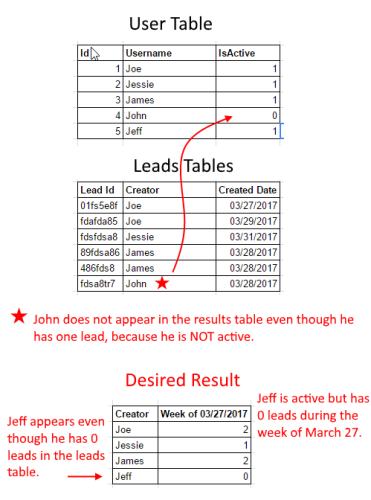Showing users that have created 0 records
-
April 2, 2017 at 10:31 am
Hi,
I'm working with a mirror of salesforce data in SQL Server 2012 and I am at the moment generating a report that shows the # of leads that were created by X user. This is easy enough to do by just doing a SELECT for the lead creator & the num of leads and creating a pivot table in excel.
However, I would also like some report to show me which active users (which I could join from a separate user table) have created 0 leads in the last week. Is there an easy way to do this?
My first thought was doing something like...taking the total list of active users, then comparing it against the list of users that did generate something and where they are not found, I'd have my list, but that would be very manual - ideally would like to build it into the query somehow.
-
April 2, 2017 at 11:58 am
Sounds like you are trying to do this with an INNER JOIN instead of an OUTER JOIN. If you right-click on the join between the two tables, you can change it. (Or just edit the SQL). An outer join will keep nulls on the many (sales) side of the join.. Instead of something like this:
SELECT Salesperson.FullName, SUM(Sales.SalesAmount)
FROM Salesperson sp INNER JOIN Sales s ON sp.SalespersonID = s.SalespersonID
GROUP BY Salesperson.FullName;
you wantSELECT Salesperson.FullName, SUM(Sales.SalesAmount)
FROM Salesperson sp LEFT JOIN Sales s ON sp.SalespersonID = s.SalespersonID
GROUP BY Salesperson.FullName;The second will show all sales people, regardless of whether they have sales.
-
April 2, 2017 at 2:24 pm
Hey pietlinden,
Thanks a lot for the quick reply. I don't think that wilil work for me but I think I did a poor job of explaining. This should help to clear it up:

-
April 2, 2017 at 5:39 pm
It would be much easier to help you resolve this if you provided some readily consumable test data. See the first link in my signature line for how to do that.
--Jeff Moden
RBAR is pronounced "ree-bar" and is a "Modenism" for Row-By-Agonizing-Row.
First step towards the paradigm shift of writing Set Based code:
________Stop thinking about what you want to do to a ROW... think, instead, of what you want to do to a COLUMN.Change is inevitable... Change for the better is not.
Helpful Links:
How to post code problems
How to Post Performance Problems
Create a Tally Function (fnTally) -
April 3, 2017 at 2:20 am
May I ask why you think a LEFT JOIN won't work for you? What's is your reasoning, have you tested?
Have a look at this simple example. Note that in the sales no Chocolate biscuits are sold, yet in the second query, with the LEFT JOIN, they are shown. Is this not what you are after?
CREATE TABLE #Item
(ItemID INT IDENTITY(1,1),
ItemName VARCHAR(20),
ItemPrice decimal(8,2));CREATE TABLE #Sale
(SaleID INT IDENTITY(1,1),
ItemID INT);
GOINSERT INTO #Item (ItemName, ItemPrice)
VALUES
('Apple', 0.4),
('Banana', 0.35),
('Orange', 0.5),
('Chicken Soup', 1.10),
('Chocolate Biscuits', 1.25);
GOINSERT INTO #Sale (ItemID)
VALUES
(1),(2),(1),(1),(3),(4),(4);
GOSELECT I.ItemName,
COUNT(S.SaleID) AS Sales, SUM(I.ItemPrice) AS SalesValue
FROM #Item I
JOIN #Sale S ON I.ItemID = S.ItemID
GROUP BY I.ItemName;--Now with a LEFT JOIN
SELECT I.ItemName,
COUNT(S.SaleID) AS Sales, SUM(CASE WHEN S.SaleID IS NOT NULL THEN I.ItemPrice ELSE 0 END) AS SalesValue
FROM #Item I
LEFT JOIN #Sale S ON I.ItemID = S.ItemID
GROUP BY I.ItemName;GO
DROP TABLE #Item;
DROP TABLE #Sale;Thom~
Excuse my typos and sometimes awful grammar. My fingers work faster than my brain does.
Larnu.uk
Viewing 5 posts - 1 through 5 (of 5 total)
You must be logged in to reply to this topic. Login to reply
